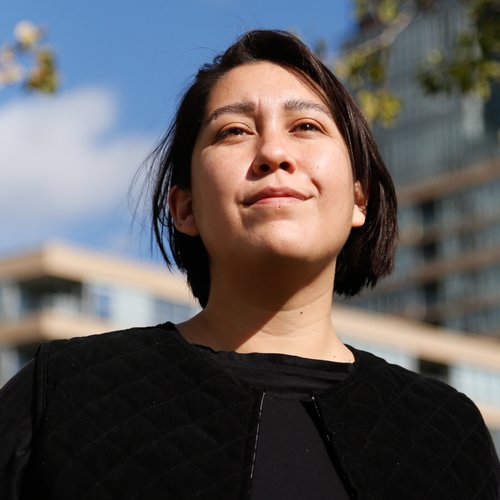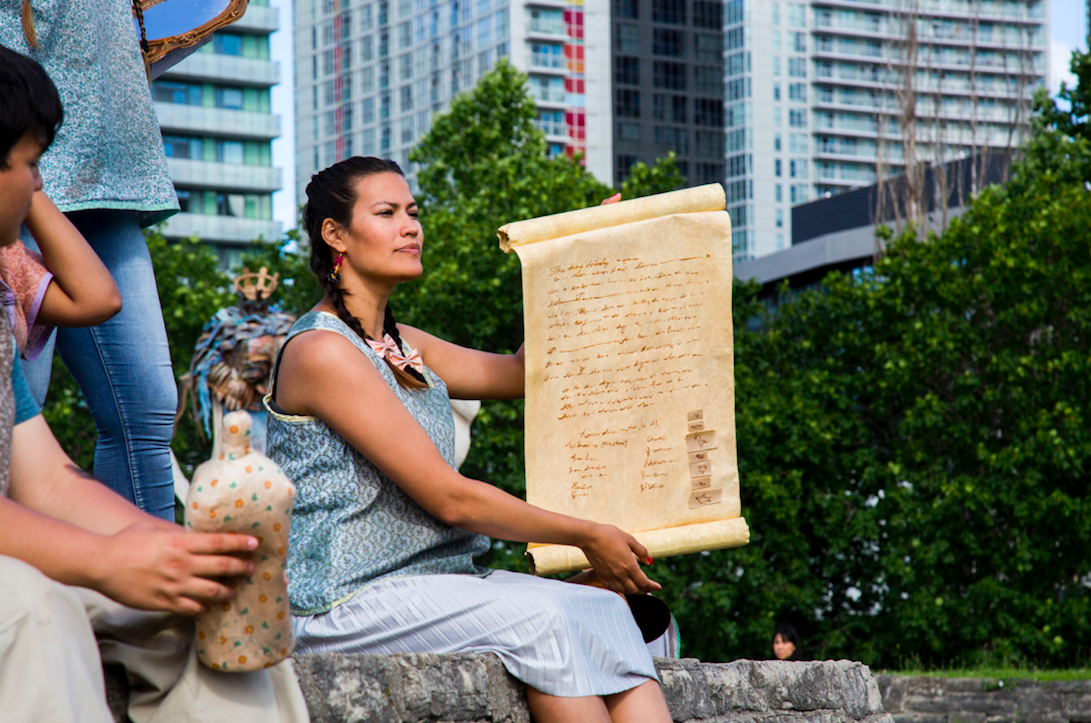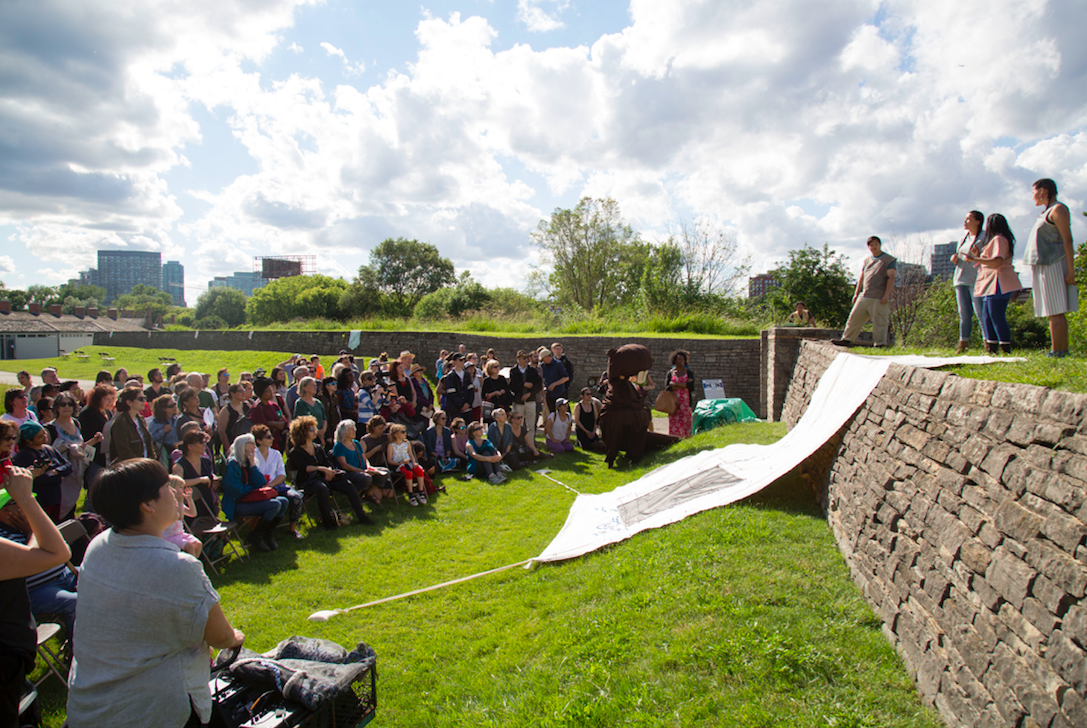October 1, 2018
Ontario Presents and its member presenting organizations recognize the importance of presenting Indigenous artists, stories and culture as part of their presenting practice. As we continue to encourage the respectful presentation of Indigenous art, we will be featuring an Indigenous artist each month in our e-newsletter and blog. Our sincere thanks to Denise Bolduc for conceiving of and continuing to support this Spotlight Series.
Spotlights are developed with the artist, and are intended simply to share the artist’s work and foster greater awareness and understanding of the strength and diversity of Indigenous art available in Ontario and beyond.
This month we spoke with multidisciplinary artist Ange Loft.
Associate Artistic Director of Jumblies Theatre, multi-disciplinary artist and performer from Kahnawake Kanienkahaka Territory, Ange is an advisor for the Toronto Biennial and for the City of Toronto Indigenous Creative Culture Fund. She’s an ardent collaborator, facilitator and mentor working in storyweaving, arts based research, wearable sculpture and Haudenosaunee history. Ange is also a vocalist with the band YAMANTAKA//SONIC TITAN.
Ange is currently directing Talking Treaties, a multidisciplinary performance project in performance at Fort York, Toronto this week (Oct 4-7th).
 Can you tell us a bit about yourself by way of introduction?
Can you tell us a bit about yourself by way of introduction?
Well, I’m a multi-disciplinary performing artist and ardent collaborator. I really like working with people, so I’ve been working with community groups and organizations since I was very young in Kahnawake… I really like cross-disciplinary work and encouraging other people to grow in those directions.
My primary [role] I guess is as Associate Artistic Director at Jumblies Theatre. And then I do spend a good chunk of the rest of my time on tour with YAMANTAKA//SONIC TITAN.
I also work lately in this new realm of Indigenous consultancy. I’m working for the Toronto biennial and for the Toronto City Council right now, for the city’s Indigenous Creative Culture Fund.
So I’m doing a lot of moving into the world of arts advocacy, and it’s always with an eye on making sure that other people are able to make work. So it’s a lot of youth-focused things.
You are incredibly multidisciplinary, you’ve done so many different things in community art, theatre, design, music, etc. – how has that developed? How have you cultivated and then maintained all of those different aspects of your practice?
I only work with certain people. Like with design projects, I have long processes that I’ve been thinking about for a long time. I work with only artists that I really like to work with…
… [For example], my sculpture gear is almost always under this idea of fortifications for self-actualization. Which is this idea that Native youth have everything they need to be strong already. It’s a design process that helps guide you towards the strengths and weaknesses and being aware of the burdens that you have.
I do a lot of design processes that do help fortify my own personal process also. Because you have to be aware of when you’re going to break when you’re carrying all of this and still trying to make art.
Every project that I do answers a real question that I have for myself. So I guess it’s this balancing act… it’s hard, but I’m not really working on anything that I don’t love.
I think I’m building towards information that’s not only for me; I think that’s a really good driving force. I’m an artist, but it’s easy to be a multidisciplinary and collaborative artist when your focus isn’t yourself.
… It’s also about projects that I can get more people in. Everything I do, I try to bring in students from CIT, or… I still try to bring in people from Turtle Island Theatre Company in Kahnawake…
I’ve seen the growth of people living in the arts and continually being invited into projects. So that’s my driving force, just trying to make projects that you can get lots of people onto the stage… or your actual audience up and dancing with you.
Why is it important to you to get more people involved in the work?
Because I got that. I had a mentor when I was younger, Kevin Saylor. He came back from New York City and started a community theatre organization. And it was just such a gift to grow up that way.
So you want others to have that…
Really that’s all it is, it’s really important, whoever you are, to live an artful life. It’s super important that we harness the abilities of our youth early.
… we’re doing a project at Fort York right now, and [we can see] how important it is to… be part of the gang to make something happen…
That project, Talking Treaties, is returning to Fort York from October 4th-7th. Can you talk a bit about that?
… We’ve talked to hundreds of people through this project. It’s a multidisciplinary performance project based in oral histories and research-based narratives around three different agreements for the Toronto area: the Dish With One Spoon, the Treaty of Niagara, and the so-called Toronto Purchase.
We look at them through archival text, mixed with oral narratives, mixed with a lot of response text and poetry that have been generated through bringing this content to different community organizations and groups.
This has been a project that’s been developing since 2015. So it’s an example of one of those long-term projects where my goal is to play around with the content with a lot of people.
We do a lot of quick creation theatre workshops, and we’ve explored the content through dance… through a lot of music making… [And] we’ve been making all of the props as part of our Groundfloor drop-ins over the past year. So we’ve really, really talked to a lot of people.
This is really just bringing together a lot of really old voices with a lot of really contemporary voices. And voices of people who don’t necessarily feel like they are treaty people, let alone feel like they have anything to say.
It’s really stunning to me some of the poetry responses we’ve had, that come out from hearing some of this content. It’s exciting to share it now.

You mentioned this is a long-term project. Do you see Talking Treaties continuing?
You can’t stop this stuff. That’s the lesson I’ve learned from this work, is the idea of returning to an idea. Returni
ng to details of an agreement, returning to the same people.
I feel like these cycles of how I approach my own work are related to this way of getting into thinking about agreement-making, long-term relationships with people, trying to make sure that we all have a little bit in the bowl.
It’s not over… we’re hoping to create an interactive installation that can be engaged with over a duration, so that it feels like an open space where you can come and learn… [then] the next plan is moving into a digital, online, educational resource-base… There’s a lot of potential.
What’s next for you? What upcoming projects are you working on?
After Talking Treaties I have a week to follow-up on my other jobs, and then I go to Europe with the band, all over cities we haven’t been to yet. And then we’re going on a North American tour.
And then I’m going to try to get back to Kahanwake sometime and continue that [community-engaged research project with Recollection Kahnawake], because that’s been on the back burner. My desire is to research my home and the agreements that are around Montreal.
I have this strong desire to drift down into New York, because that’s Mohawk territory, that’s Kanien’kehá:ka territory. It’s my personal drive and interest to know and track the history that covers the whole of Kanien’kehá:ka territory.
I also just really love reading, so it’s a good excuse to learn things if you can also make art.
Thank you to Ange for sitting down with us!
This interview has been edited for length and clarity.
Photos by Liam Coo

